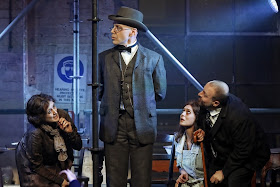It’s almost 40 years since Philip Glass’ Satyagraha premiered in 1980, a work commemorating the life of Mahatma Gandhi and commissioned by the city of Rotterdam. With its audacious mix of pulsing orchestral writing, ethereal vocal overlay and a libretto that conceptualises rather than elucidate his life, Satyagraha represents one of the late 20th century’s prime examples of composition that has given unique form to operatic style.
 |
| Sean Panikkar as Gandhi with LA Opera Chorus |
'Satyagraha' was a term adopted by Mahatma Ghandi to describe his philosophy of non-violent resistance, meaning “truth force” in Sanskrit. The opera’s three acts depict episodes in his life, loosely based on Gandhi’s 21 years in South Africa. Each act is headed by an historical figure who all have a connection with Gandhi in reflecting the work’s central message of pacifism - the Russian novelist Tolstoy (Act 1), the Indian poet and activist Tagore (Act 2) and King, the American civil rights leader (Act 3). They preside high above the stage, in a small boxed niche, mostly inconspicuously, as part of associate director Julian Crouch’s inspired designs featuring an imposing rusted corrugated arced wall.
What gives the impression of being more an expressive sketch of Gandhi’s philosophy, both mythical and real aspects are integrated into the fabric. Constance De Jong’s libretto, adapted from the epic 700 verse Hindu scripture Bhagavad Gita and which Gandhi knew and studied, maintains the Sanskrit text. When sung, little is given away apart from a sprinkling of projections across the curved wall. Even without fragments such as “Outstanding is he whose soul views in the selfsame way friends, comrades, enemies”, McDermott’s stylistic and gently-moving direction sends its calming waves of pacifism across the theatre. For those who accept its message, time becomes both irrelevant and uplifted.
 |
| J'Nai Bridges, Morris Robinson, Sean Panikkar and Erica Petrocelli |
The power of Glass’s work lies in its ability to express his concept’s essence in the most reductive, resonating and mystical way. The score is limited to strings and woodwind, comprising simple repetitions that metamorphose into others and cast their hypnotic quality with ease. The fluid and meandering beauty achieved by conductor Grant Gershon only lacked an occasional desire for punctuated intensity but the players of the LA Opera Orchestra captivated with playing as precise and consistent as a Swiss watch.
Leading us in the way of peace, Sean Panikkar becomes Ghandi incarnate. With a golden tenor both youthful and commanding, Sean Panikkar was a champion in imparting humility and charisma throughout. From discriminated immigrant to humble activist, Panikkar not only looks the part in presenting Gandhi’s transformation from the English suited lawyer to white Indian dhoti, but seemingly channels Gandhi’s spirit. In Panikkar’s breathtaking and passionate performance, Gandhi is elevated as a disciple to the echelon of gods, appropriately honouring the title Mahatma, meaning “venerable” and “high-souled”.
 |
| ean Panikkar as Gandhi with LA Opera Chorus |
In the final scene the walls part, leaving King poised precariously high at his lectern. He turns to Gandhi in a symbol of respect before Gandhi’s chants stab the soul with their searching repetitions. How can he appear so alone as a leader practising truth through peace? Shockingly, on a daily basis, our world seems empty of such leadership. Today and always, there needs to be a place for Gandhi and Glass’ Satyagraha.
Satyagraha
LA Opera
Dorothy Chandler Pavilion, LA Music Centre
Until 11th November, 2018












